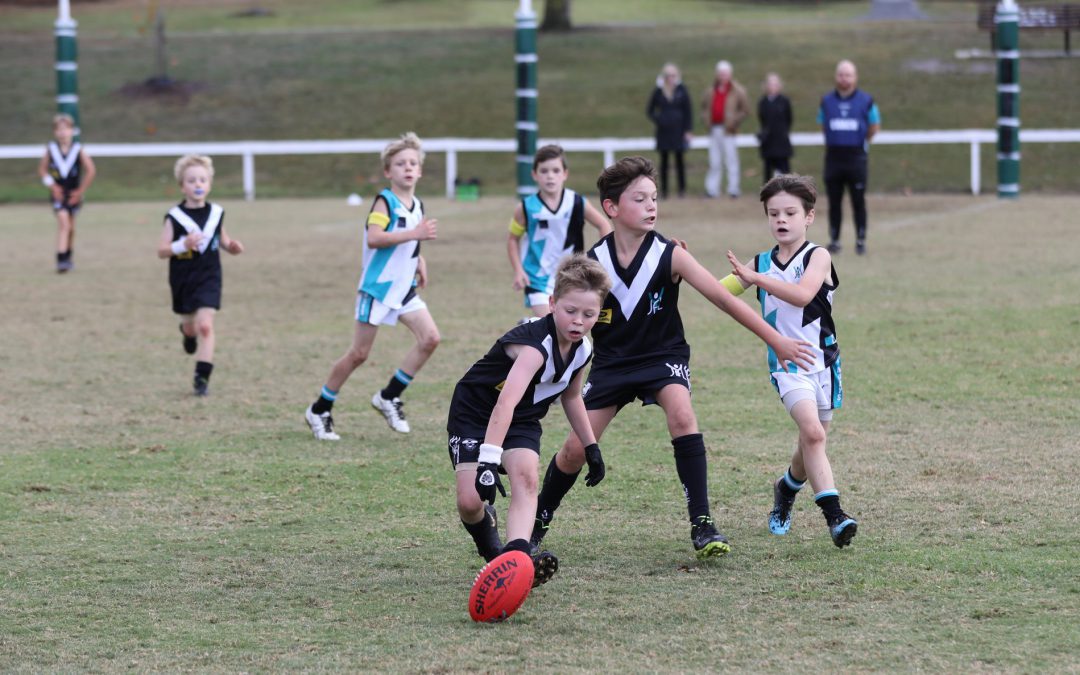
by teamvida | Oct 21, 2019 | General Footy, Player Development
Coaches should understand the importance of trying to add, and/or set KPI’s for hand-balling to a player running from behind.
What we mean by this is to have a player running past another player who has either marked the ball or received a free-kick. The player receiving the ball should be running at a reasonable pace to try and get the ball forward faster than what the marking player would.
The below example of how fast the ball can be moved forward from a running player, creating a situation where the defence may not be set-up properly.
At all levels of junior footy, this tactic should be taught to your players. One way to try and get your players to do this is to set some KPI’s for the amount of hand-ball receive from stationary. Obviously, with the younger ages you would not be as harsh on the results of them trying the tactics, but as the ages and abilities progress, you should make your players aware of the way it changes the game.
Set a reasonable KPI for your team and remind them during the quarter and half time breaks. When there is a successful passage remind your players and use the resulting KPI’s to justify the results.
Your KPI numbers should be around the following
Tackers – 10’s 5 per game
10 -12’s 2 per quarter
12′-14’s 2-4 per quarter
14 and up 5 per quarter
Advantages of Play
Some of the advantages of the play are:
- Ability to move the ball forwards fast
- Get the opposition out of position
- Take advantage of fast players
- Clear different zones of the field
- Rebound fast out of defence
- Teach your players to ability to look for different options

by teamvida | Oct 14, 2019 | Coach Development, General Footy

This week we will briefly talk about communication from your players. Communication from your players is important for many different reasons. We are going to break this down into two main areas:
- Communication on the field to players
- Communication to coaches
Helping your players improve in both these areas will not only help your players on the field, but also help your as a coach. At all levels of sport, players have different communication techniques and skills, so making your players aware of their own individual traits and personalities can help your team as a whole.
Communication from players on the field
Players on the field need to communicate well to each other in order to work as a well organised, successful team. Teaching your players to use their voice more in certain situations on the field will not only help themselves, but their teammates around them.
Two way talk – This is not a new concept, but not often used in junior footy. What we mean by two way talk is to have players not only calling for the ball, but also calling out the name of the player they are passing too. For example, if you have the ball, you will call out the players name you are wanting to pass to. This helps the receiving player understand the purpose and intention of the ball carrier.
Additionally, communication around stoppages and around general play will also help your players. Teaching players to always talk when the ball is close to them will help all their teammates around them. If a player gets a clearance, make sure players around them are telling him/her how much time they have or how much room they have before they need to distribute the ball.
Another great example of important communication is players who are around stoppages. There quickly needs to be verbal and non verbal communication about the where the ruck will try and tap the ball, and also communication about match-ups.
Communication from players to the coaches.
As many of you coaches are aware, to best help your players, you need their feedback so you can learn from them. Getting your players to communicate their ideas, concerns, positives and negatives to the coach can help the team as a whole.
Some ways in which to seek feedback from your players are to use surveys after each game, or throughout the season. These can be as simple as a one small sheet of paper handed out after the game which can be delivered back to the coach at the next training session. Reviewing the answers to these questions can help you build your knowledge of what your players want or what they are having concerns with.
This can then lead to face-to-face communication in which is important for your players to learn. Get your players to understand that feedback to the coach is welcome. Get them to tell you what they enjoy about the game or their position. Moreover, get them to tell you what they do not like. Again, you want to use this information to make you a better coach to ultimately help with the team’s success on-field and success in skill development.

by teamvida | Oct 7, 2019 | Coach Development, General Footy, Player Development
These diagrams can assist with your set ups for boundary throw ins at almost all levels and age groups. Making your players aware of tactical differences in the game contributes significantly to their overall development.
Take a look through the diagrams below

Mid Wrap
With this boundary throw in set-up, we want to have all your players in front of their opponents on the ruck side of the opposition. This set-up would predominantly be used in the attacking half of the ground. The nominated on-baller would attack the ball whilst their team-mates would block for him/her. The wing would be behind the ruck and could be used as an outlet to transition the ball forward. It’s still important to keep distance amongst team-mates as to not clog up the contest.
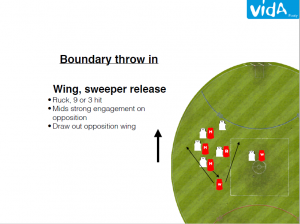
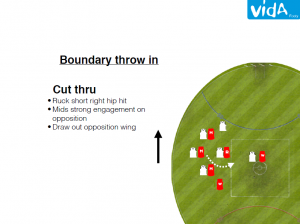
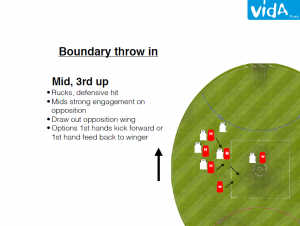
Set-ups For Younger Players.
Again, like most of our other tactical set-ups, younger players should start thinking about their position on the field. Please remember to explain to your players the “why” of the set-ups so they understand the purpose.
A suggestion for a boundary throw in set-up is to have your players standing around the contest with at least two meters between them on the closest team-mate. Then you could make a team rule that the closest player to the ball goes for it, whilst the other players either block or receive the ball.
These skills can be worked on in simulated contests at training in two or three small groups with assistant coaches helping. Moreover, small and medium handball grids would also work well in working on creating space, blocking, handballing on 45’s and working as a team.
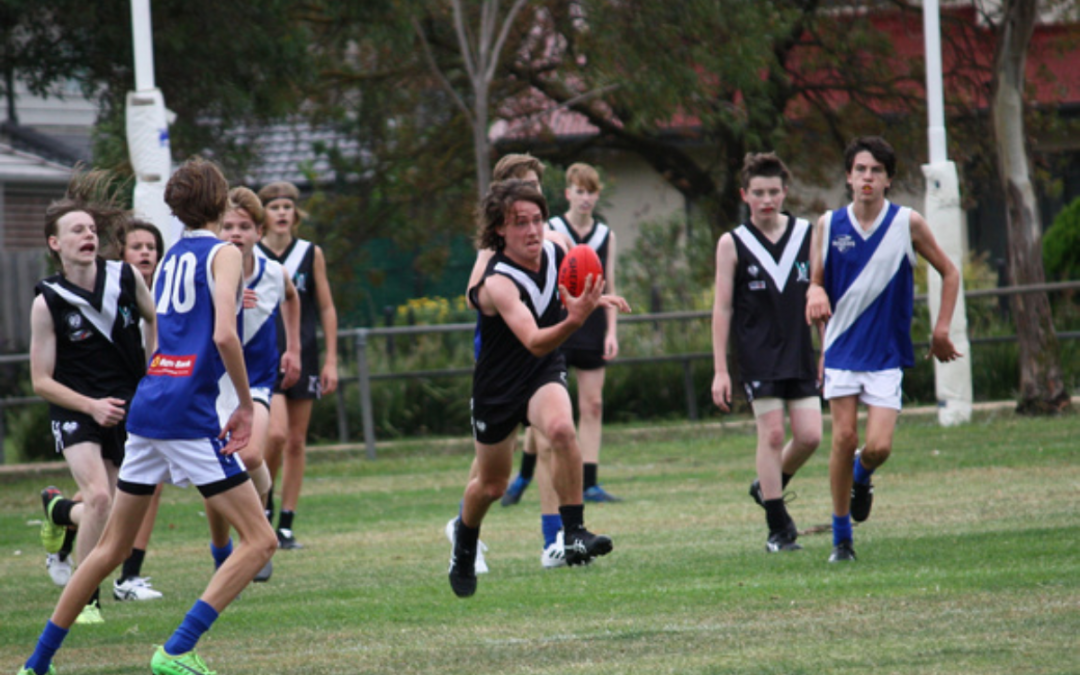
by teamvida | Sep 30, 2019 | General Footy, Player Development
Defensive running is something that is often looked over in junior footy. Everyone loves kicking goals, however we need to teach our players to stop goals in order to win games. This becomes identified as a deficiency when many players come into senior footy. As junior coaches, we want to develop a player as a whole, therefore teaching players to run defensively is really important.
Running defensively is to run as hard and as intense to the correct positions to influence the game. The running has to be just as intense and as fast as if they are trying to kick a goal.
Even though training has been done for the week, below is a great activity to work on the defensive side of the game.
A sound defensive strategy significantly helps winning games, especially in the finals. So take some time this week to set up for the finals series if your team is playing. You can still have a defensive goal if your team is not playing finals.
Young Players
Without going into too much detail, younger players need to understand to keep running defensively as much as they can. Even though some levels have zones, it’s important to teach players to move defensively until they are no longer needed in the contest.
Teach your players to to always be watching the ball, plus trying to read where the ball is going to go. If your team has the ball, teach your players to always be thinking of positioning. If the ball is turned over, they will be able to better position themselves defensively.
One of the biggest selling points to defensive running in the younger age groups is communicating to the players the purpose of the technique. Every player wants to kick goals, however, you only win games if you score more than your opponent. Explaining all the ways in which players on a team can help win a game of footy will help your players understand the aspects of the game where they don’t need to have the ball to influence the game.
12/13’s and Up
This is where a real progression can take place each year from now. Players need to understand defensive running needs to be just as hard as running to try and get a goal. If this message gets communicated, then a lot of players will understand. Players also need to be taught to take pride in their defensive efforts to help the team’s overall performance.
Things to think about when trying to develop defensive running
– Teach players to turn and sprint to the next available player when the ball gets turned over
– Make sure players are always in the correct position even if in possession of the ball
– Get players to understand two-way running should be the same high intensity
– Teach players to take pride in being defensive
– Teach your taller players to run deep to the goal line on set shots
– Get your players to run into defensive 50 to plug up holes in the defence.
– Teach players to zone off in their defensive running, and if they need to take their non-direct player for a while, that’s fine.
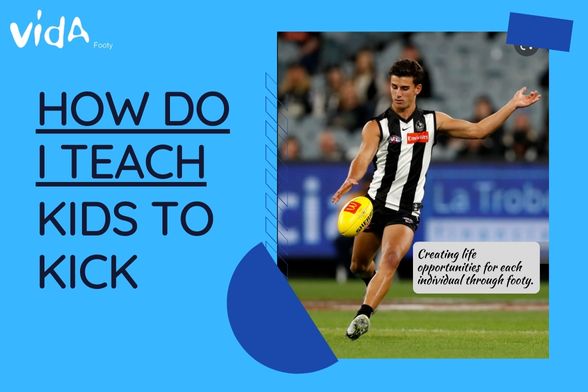
by teamvida | Sep 23, 2019 | General Footy, Player Development
Kicking needs to be worked on throughout all levels of Junior Footy. Even when watching some local senior footy on the weekends, it is surprising to see so many adults kicking with bad technique. The main problems we notice are;
– Two hand ball drop
– High Ball Drop
– Tossing the ball up slightly to kick
– Kicking across the line of the ball
– Ball not spinning properly
These issues can all be fixed throughout the junior development stage, and as coaches, one of your goals should be to leave players with better skills than what they came into the year with.
Main things to Work on.
The biggest thing we need to work on with our players in the ball drop. The ball drop accounts for most players ability to be a good kick or not. The ball drop is made up of
– The grip
– Alignment
– Ball drop height
– Ball drop position
Holding the ball correctly is important as it assists in getting the rest of the kick right. Players want to make sure they hold the ball with their hands on the outside of the ball. Then you want to tell your players to point the end of the ball to the ground (a lot of players will point it to where they want to kick it).
From there, you want to try and align the ball predominantly on their preferred kick side, trying to avoid swaying from left to right.
Then we want the ball drop to be below the players hips, with their fingers pointing to the ground. The opposite arm then goes out to the side to assist in balancing. Getting your players to really understand the ball drop with significantly help their kicking.
How to add technique work into a session.
During the warm-up phase of the session you can add some simple kicking (2 players one ball) to ensure plenty of volume. You can then go around to every player and asses their kick. Get players to try and hit a particular goal of kicking and marking 10 in a row, or count how many kicks they have had.
Additionally, before the session starts, players must do 100 kicks to themselves on each footy before training starts.
Throughout the training session, you can separate the group into smaller groups, and have one of those be a technique group. Remember, this is not limited to really young players, as a lot of players even up to the age of colts need to work on kicking technique.
How to add technique work into a session.
During the warm-up phase of the session you can add some simple kicking (2 players one ball) to ensure plenty of volume. You can then go around to every player and asses their kick. Get players to try and hit a particular goal of kicking and marking 10 in a row, or count how many kicks they have had.
Additionally, before the session starts, players must do 100 kicks to themselves on each footy before training starts.
Throughout the training session, you can separate the group into smaller groups, and have one of those be a technique group. Remember, this is not limited to really young players, as a lot of players even up to the age of colts need to work on kicking technique.
Suggested activities available for Vida members:
One Step Five point Kicking – Click here
Kicking Square – Click here
Kick slide and handball – Click Here
Small Kicking Grid
Kicking Technique with Anth
Forty Five Gates – Click here
Again, there are plenty more on the website. Simply tick kicking in the search options and go from there.
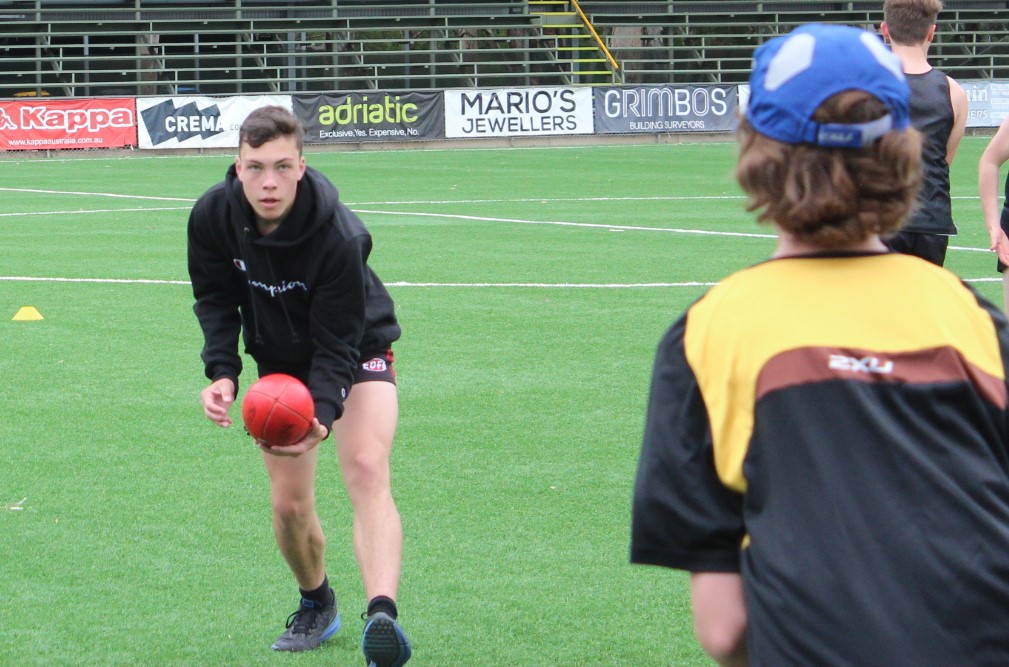
by teamvida | Sep 16, 2019 | General Footy
We have run several Skill Development Programs and Clinics at our holiday clinics. One of the main skill development areas for young players is handballing. In the past we have noticed many players still not executing the skill correctly. We suggest coaches think about ways in which you can help impact your players into being better in disposing the ball from short distances.
The main concern is that players were throwing and punching the ball out of the air and hurting their wrists, therefore they didn’t want to handball over long distances.
As coaches, we need to make sure one of the simplest skills are up to scratch.
From experience in running footy camps, weekly programs and doing private footy lessons, players should be able to handball the ball properly even at a tackers level.
Spending extra time in your session dedicated to skill acquisition with all levels and ages will see your players improve at a much faster rate. Below there are some suggested activities to implement more handballing. If you have any further questions please contact us and we can help. Have a great week!
Technique Tips.
The following technical points are crucial to enable your players to handball effectively. As your players progress, you can choose more of these points to work on.
– Hand under the ball
– End of the ball pointing slightly up
– Punch the ball with a downward motion of the back top of the ball
– Contact arm should be bent, almost to a 90 degree angle
– Punching hand to finish in holding hand
– Step forward with opposite foot when contacting the ball
– Swings arms forward to promote momentum
– Ball must spin backwards!
Suggested Activities for Vida members:
Technique Explanation #84 Click here
Kick and Slide with Handball #74 Click here
Handball Grids #104 Click here
Handball Grid with mini goals #135 Click here
There are plenty more handball related activities on the website. Please select handball when searching in the right hand side bar to refine your search.












